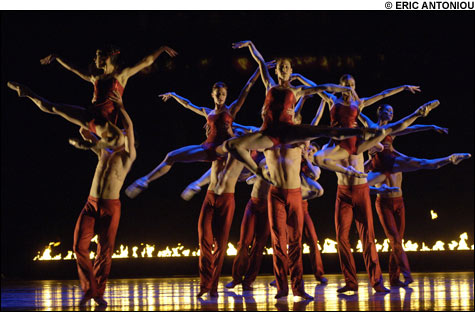
LE SACRE DU PRINTEMPS: Lighting up the Wang in Jorma’s Elo new ballet to Stravinsky’s score. |
"Burning down the house" is a metaphor, and at the Wang Theatre this weekend, the Boston Fire Department will be on hand to ensure that it remains one. All the same, you can have a hot time at Boston Ballet's season finale, where, in a major new work, Jorma Elo's incendiary Le Sacre du Printemps, it's not just the flames flickering in the background that light up the stage.
It's fitting that the company should bid farewell to the Wang — it will stage all its productions at the Opera House next season — with a dynamic program celebrating the centennial of the Ballets Russes. Serge Diaghilev's company kicked ballet into the 20th century, with its avant-garde composers (Stravinsky, Debussy, Ravel, Prokofiev) and choreographers (Fokine, Nijinsky, Nijinska, Balanchine) and designers (Benois, Bakst, Picasso) and dancers (Nijinsky, Karsavina, Lifar, Danilova). Put Schéhérazade, Firebird, Petrouchka, Les Noces, or Apollo up against most contemporary choreography and it's the newer stuff that seems dated. In this trio of Ballets Russes originals — Balanchine's The Prodigal Son (1929), Fokine's Le Spectre de la Rose (1911), and Nijinsky's Afternoon of a Faun (1912) — plus resident choreographer Elo's version of the most famous Ballets Russes piece of all, Boston Ballet looks forward as well as back.

These four works are also modern in their focus on the isolation of the individual. Nineteenth-century story ballets are about community and romance; only Giselle and La Sylphide end in death and desolation. Balanchine's Prodigal is fleeced by the Goons, seduced by the Siren, and deserted by his two friends; when at the end he crawls back into the embrace of his father, it's as if he were re-entering the womb. In Le Spectre de la Rose, a young woman who's returned home from a ball bearing a rose falls asleep in an armchair and is visited by the title apparition, the man of her dreams, with whom she dances — but was it all a dream? By the end, she's alone again. Afternoon of a Faun opens with our hero in solitary splendor atop a rock, playing his flute and munching on grapes — until some nymphs troop by on their way to bathe in the lake. He cavorts briefly with one of them; she drops a silken scarf before slipping away, and he takes it back to his perch, stretches it out, lies on it, masturbates. In Nijinsky's Sacre, a virgin is chosen from the community to be sacrificed to the earth. Elo's ballet takes up the same theme.
Boston Ballet last did Prodigal in 2003, with Yury Yanowsky as the opening-night Son; his Prodigal leap was, I recall, so prodigal that it nearly carried him off stage. Six years later, he's not quite as extravagant in that first tableau, where the Prodigal breaks free of his overbearing father and his two sisters and takes his goods and leaves, jumping in a single bound the picket fence that will later become a table and a cross and a ship. But Yanowsky is just as intense as he was in 2003, and dancing as well as he ever has. His wild-child Prodigal is boyish and optimistic and more than a little incredulous when he's crucified and stripped (the way he hangs off the cross, he could be modeling for a Deposition); by the time he drags himself home, all pride is gone.
Melanie Atkins also danced in Prodigal in 2003, though not with Yanowsky. She can be devastating in Balanchine (think of her Russian Girl in Serenade, or her Duo Concertant), but her natural impulse is to flow rather than to pose, so the Siren's stylization isn't ideal for her. That said, she's weighted and personalized her pelvic movement since 2003, and she gives a warmer and more insinuating reading (not the least of which are the blandishments with which she plies Yanowsky as they're sitting quietly upstage) than the ones I saw from Agnès Letestu and Marie-Agnès Gillot in Paris in 2003. She's retiring after this production to become the children's ballet mistress for Boston Ballet School — our loss, the kids' gain. Sabi Varga and Bradley Schlagheck are athletic and suitably heartless as our hero's friends; the Goons are as scary as you could wish for. And it would be hard to imagine a better father than Arthur Leeth, who's the embodiment of patriarchal, good and bad.